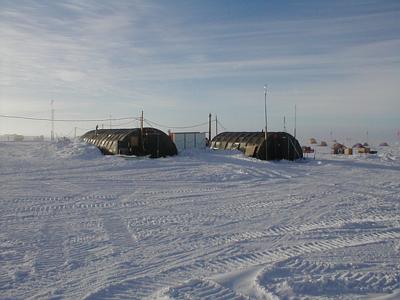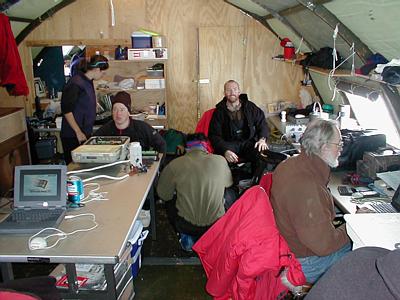22 November, 2000
Siple Dome Field Camp
The current population here at the Dome is sixteen. That can change if a plane lands. Two were scheduled for today but neither made it in due to poor weather at McMurdo Station. Four people make up the camp staff. The other fourteen belong to the five science teams presently operating out of the camp.
There are two "buildings" that form the core of the field camp. They are called Jamesways, military shelters of Korean War vintage. These are temporary structures built in sections. The floors are painted plywood, military green of course. The curved roof consists of a double-layer of insulated canvas overlaying a wood frame. They are heated and quite comfortable when coming in from the cold. Jamesways are five meters (sixteen feet) wide. Their length depends on the number of sections they have.
The large building is fifteen meters (forty-eight feet) long. It houses the kitchen and dining area. The smaller Jamesway contains the communications room and the science area. It is quite crowded right now with so many science teams in camp.
On the west side of camp are the living quarters. There are about a dozen multicolor nylon tents. There are also two outhouses painted black for warmth.
Just south of the Jamesways are piles of outgoing and incoming material. The parking area for the two tractors and the snowmobiles is nearby. A bit farther out is the skiway where planes land and takeoff, on skis of course.
A two-minute walk in any direction will put you in an endless expanse of flat, white emptiness. The surface of the snow is wind packed and crunchy. Footsteps sink in about three to ten centimeters (one to four inches). This is a unique and beautiful place.

The Jamesways. The one on the left houses the kitchen and dining area. On the right is the communications and science shack.

The interior of the science area is a bit crowded with twelve people sharing the space.

The blue and yellow tent surrounded by the flags is where I sleep. The black triangular structure is the outhouse.
Contact the TEA in the field at
.
If you cannot connect through your browser, copy the
TEA's e-mail address in the "To:" line of
your favorite e-mail package.
|
